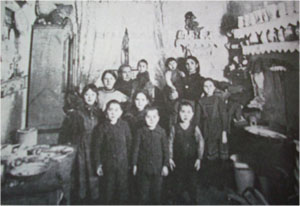3. Living conditions of a working-class family
C1. A ground plan of a tenement with seven flats per floor
 Click image to enlarge
Click image to enlarge
Source: Bäuml-Stosiek, Dagmar u.a.: Forum Geschichte 11 Bayern, Berlin 2009, S. 85.
C2. A photograph of a working-class family in their kitchen
 Click image to enlarge
Click image to enlarge
Source: Schmid, Heinz Dieter (Hrsg.): Fragen an die Geschichte. Geschichtliches Arbeitsbuch für die Sekundarstufe I (Bd. 3), Frankfurt a.M,⁴1981, S. 42.
Questions
Geographical/Historical Context
The tenements in the cities were constructed to house as many workers and their families as possible. These families could not afford appropriate housing space with small income at their disposal. This problem could be particularly encountered in the big cities, which had to adjust to the new situation and to provide housing space for the workers.
Answer to the Questions
1:
- Living conditions: many family members (high birth rate) share little living space, child labour.
- small flats, (probably) no electricity and no running water available, few pieces of furniture and possessions.
2:
- Hope for work and wealth in the city.
- Unemployment in the countryside.




Presentation
The agglomeration of crowds coming from countryside to town often led to a huge housing shortage.